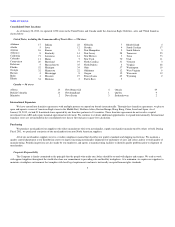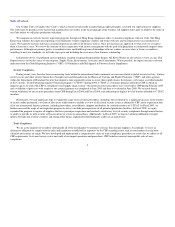American Eagle Outfitters 2011 Annual Report Download - page 11
Download and view the complete annual report
Please find page 11 of the 2011 American Eagle Outfitters annual report below. You can navigate through the pages in the report by either clicking on the pages listed below, or by using the keyword search tool below to find specific information within the annual report.
Table of Contents
Our corporate governance materials, including our corporate governance guidelines, the charters of our audit, compensation, and nominating and
corporate governance committees, and our code of ethics may also be found under the "About AEO, Inc." section of our website at www.ae.com. Any
amendments or waivers to our code of ethics will also be available on our website. A copy of the corporate governance materials is also available upon written
request.
Additionally, our investor presentations are available under the "About AEO, Inc." section of our website at www.ae.com. These presentations are
available as soon as reasonably practicable after they are presented at investor conferences.
Certifications
As required by the New York Stock Exchange ("NYSE") Corporate Governance Standards Section 303A.12(a), on July 5, 2011 our Chief Executive
Officer submitted to the NYSE a certification that he was not aware of any violation by the Company of NYSE corporate governance listing standards.
Additionally, we filed with this Form 10-K, the Principal Executive Officer and Principal Financial Officer certifications required under Sections 302 and 906
of the Sarbanes-Oxley Act of 2002.
ITEM 1A. RISK FACTORS
Our ability to anticipate and respond to changing consumer preferences, fashion trends and a competitive environment in a timely manner
Our future success depends, in part, upon our ability to identify and respond to fashion trends in a timely manner. The specialty retail apparel business
fluctuates according to changes in the economy and customer preferences, dictated by fashion and season. These fluctuations especially affect the inventory
owned by apparel retailers because merchandise typically must be ordered well in advance of the selling season. While we endeavor to test many merchandise
items before ordering large quantities, we are still susceptible to changing fashion trends and fluctuations in customer demands.
In addition, the cyclical nature of the retail business requires that we carry a significant amount of inventory, especially during our peak selling seasons.
We enter into agreements for the manufacture and purchase of our private label apparel well in advance of the applicable selling season. As a result, we are
vulnerable to changes in consumer demand, pricing shifts and the timing and selection of merchandise purchases. The failure to enter into agreements for the
manufacture and purchase of merchandise in a timely manner could, among other things, lead to a shortage of inventory and lower sales. Changes in fashion
trends, if unsuccessfully identified, forecasted or responded to by us, could, among other things, lead to lower sales, excess inventories and higher
markdowns, which in turn could have a material adverse effect on our results of operations and financial condition.
The effect of economic pressures and other business factors
The success of our operations depends to a significant extent upon a number of factors relating to discretionary consumer spending, including economic
conditions affecting disposable consumer income such as employment, consumer debt, interest rates, increases in energy costs and consumer confidence.
There can be no assurance that consumer spending will not be further negatively affected by general or local economic conditions, thereby adversely
impacting our continued growth and results of operations.
Our ability to react to raw material, labor and energy cost increases
Increases in our costs, such as raw materials, labor and energy, may reduce our overall profitability. Specifically, fluctuations in the price of cotton that
is used in the manufacture of merchandise we purchase from our suppliers has negatively impacted our cost of sales. We have strategies in place to help
mitigate the rising cost of raw materials and our overall profitability depends on the success of those strategies. Additionally, increases in other costs,
including labor and energy, could further reduce our profitability if not mitigated.
9
























